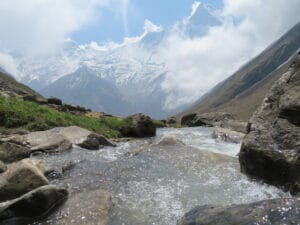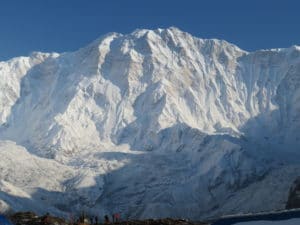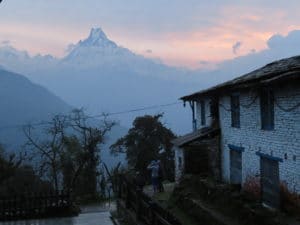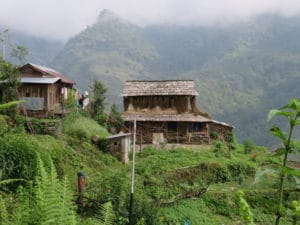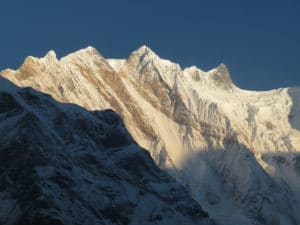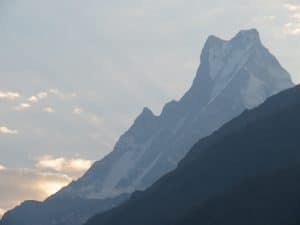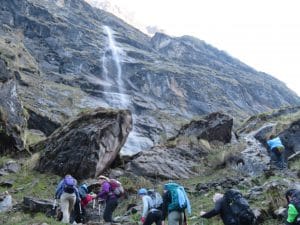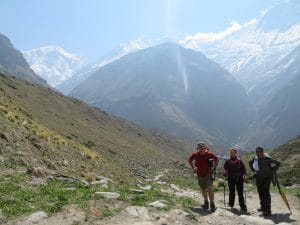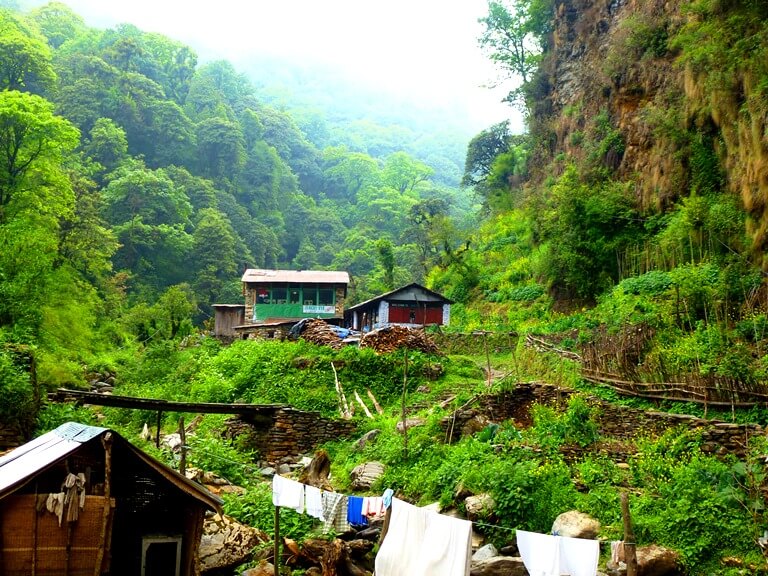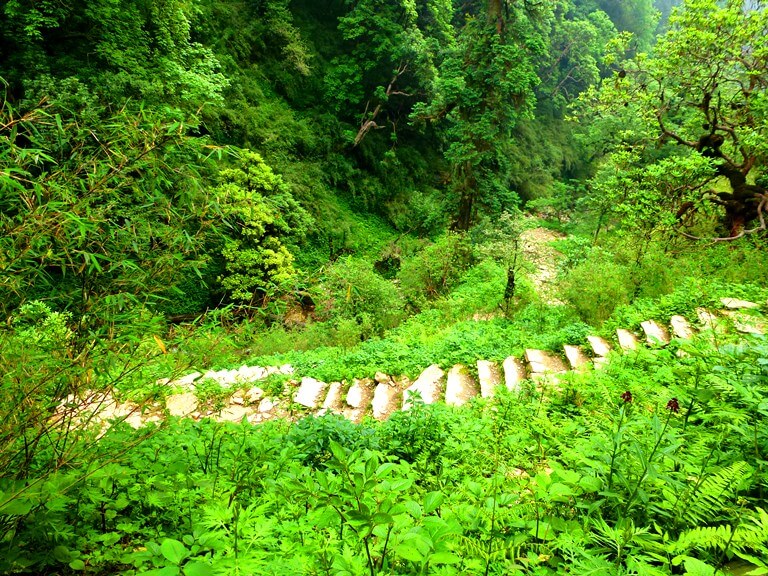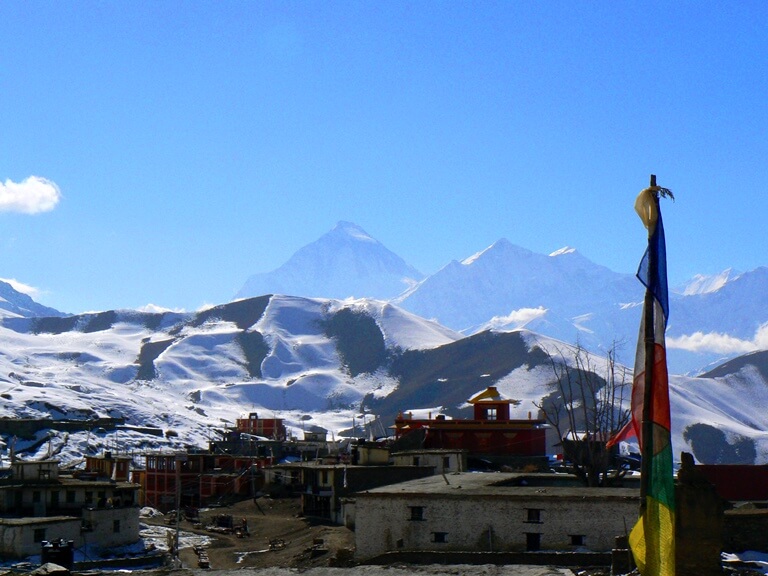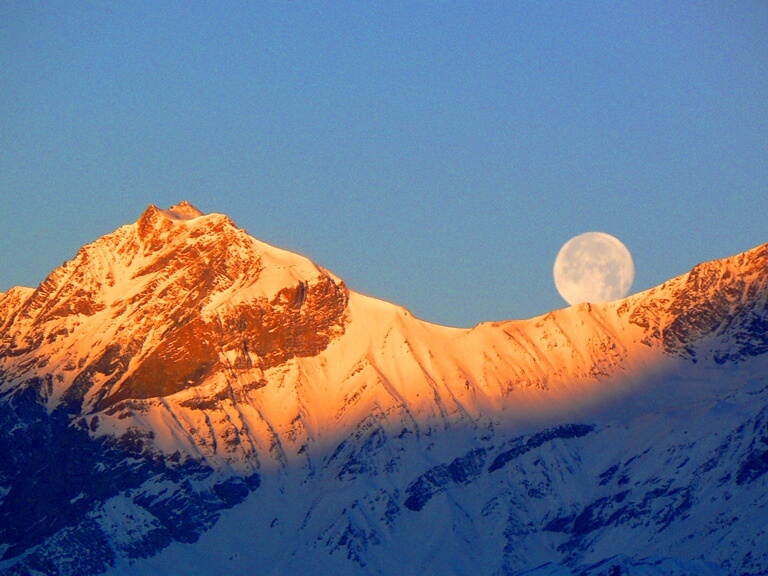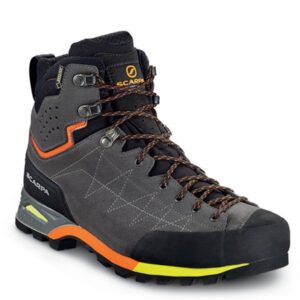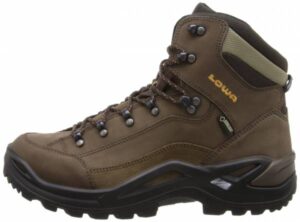Annapurna Circuit Trek
The Annapurna circuit includes Annapurna, Manaslu, Dhaulagiri range, fascinating landscapes of Mustang, Muktinath Temple, Braga village, numerous monasteries and the Kaligandaki gorge. Completing the Annapurna Circuit trek is one trek not to be missed!
Tips & Advice
We have led hundreds of people to Annapurna Base Camp over the past 10 years! Here are ten reasons why you should choose Ian Taylor Trekking to the base of the world’s most dangerous mountain. We run around 10 Annapurna Base Camp treks per year. Our full time staff are ready to lead you on all our trips across Nepal. We have more acclimatization built into our itinerary, giving better safety and success. Read some REVIEWS from our trips.
1). Our Award Winning Team
We have four guides for every group of ten trekkers on the trail! This sets up apart of other groups. We want to make sure all of our teams have the best chance at safely reaching their goal. With more staff on the trail with your team, they will be able to more efficiently manage your safety on the trail and also give you a better experience along the way.
We do not outsource any of our treks and we have our own office in Kathmandu. All of our guides hold current Wilderness First Aid Certificates. They are able to get you the help you need in case of an emergency. Also, our guides will carry satellite and local phones with them. Read some REVIEWS from our treks.
2). Supporting the Local Community
We continue to support the local community in Nepal. In 2015 we helped establish the Goli Village Trust in Nepal. A lot of of staff come from the village of Goli in the lower Everest region of Nepal. We have built two schools in the Goli region and we have placed stoves in over 60 homes. We do need donations and help, therefore if you would like to donate, set up a trek to the village, give funds, clothes or school items, then get in touch. Please let us know and we can help you figure out how you can best help!
4). Expert Training Advice
We offer personal service with training advice for our clients, 5 days a week. A lot of people underestimate Himalayan trekking. We do not want to see this happen with our clients. Therefore, we want to make sure that you have the best information on how to complete the trek safely and successfully.
There are some long hiking days, covering over 600m/ 2,000 feet of up and down hill on steps or stairs while on the trail. We have professional training advice available to you 5 days a week and we can schedule calls with you as often as needed once you sign up to our trips.
5). 25 Years Experience
We have years of experience managing teams on the ground in Nepal. Our head guide has been at the forefront of tourism in Nepal for over 25 years. He is well connected on the ground with access to all the key organization and authorities. He is also passionate about the Sherpa culture, experience and preserving these traditions.
Anyone who has trekked with Dawa Chirri Sherpa will never forget it! Even if you just get to spend time in Kathmandu with him, you will love and cherish the experience. Dawa is married to Kay from Scotland, and they run our office together in Kathmandu. All of our clients joining trips to Annapurna Base Camp will experience the hospitality and quality service we have to offer.
6). 4 Star Hotel in Kathmandu
We include two nights in a hotel in four star hotel in Kathmandu. One night before your trek and one night after. All of our trips are on a shared basis, but if you prefer a single room, this can be offered at an additional cost. We use the Buddy hotel in Thamel, which is the main tourist district of the city. You can also upgrade to 5 star hotel option if you like, just ask us for further information.
7). More Acclimatization
We have learned after years of experience that people need more time to acclimatize to the lower levels of oxygen, in order to have a safe and successful trip. Therefore, we live to include a trek to Poon Hill 3,210m/ 10,531 feet before heading towards Annapurna Base Camp. This added acclimatization sets you up nicely for for a great trekking experience into lower levels of oxygen. Having more days on the trail and more acclimatization increases safety, success and enjoyment.
8). Celebration Meal
We like to treat all of our teams to a celebratory meal at the end of your trek in Kathmandu! Ian’s favorite restaurant to enjoy after he is in the mountains is Fire and Ice Pizza Restaurant. Most of our teams will have the meal there as you can enjoy some delicious pizza after the trek (maybe even have a delicious mojito). This meal is included in the trip. You will be presented with your Everest Base Camp certificate of achievement and we will enjoy a beautiful meal before heading back to the hotel or a night out on the town.
10). Different Itinerary Options and Small Groups
We have multiple options for itineraries to Annapurna Base Camp. Our most popular itinerary treks to Poon Hill first, then treks to the main Annapurna Base Camp trail and back via the Jhinu hot springs. We can also tailor your trip to suit your needs for a private group. Therefore, if you have 4 or more people joining a trip, we can cater your private itinerary at no extra cost!
We only work with small group sizes. The maximum number of people per team will be 10 people. Some of our groups are even less people with only 6 or 8 team members. This will therefore give you are more personalized experience on the trail to Annapurna Base Camp. You can move as a team and experience more of this world class trail.
Contact the Trekking Experts
Just drop us a mail and we can schedule a time to chat. for more information on our treks. Read some REVIEWS and book early to secure your space on this trip of a lifetime!
We have extensive experience leading treks in the Annapurna region of Nepal. After years of work, we have added all our important links and pages in one location for you to explore and get the information you need. If you are thinking to trekking to Annapurna Base Camp, then we are always happy to schedule a call with you to answer all the questions you have. CONTACT US today and start planning for your trip to Nepal!
Picking the Right Itinerary
The most important things to consider when you are preparing for your trek; making sure you have chosen the right itinerary, putting in the correct physical preparation, and have the right team to get you to your goal. Ian has climbed Mount Everest to the summit and led over 10 treks to Annapurna Base Camp over the years. We have the experience in the region to make sure that you have all the best information for the trip. Check out our upcoming trekking dates.
Important Annapurna Base Camp Pages
1). Pick the best acclimatization itinerary for your Annapurna Base Camp trek
2). How you should be training to best physically prepare for your trek to Annapurna
3). Get FREE constant advice from our professional team
4). Understand the daily distances you will travel on the trek to Annapurna
5). Have the right clothing and gear for your Annapurna Base Camp trek
6). Pacing each day on the trail is critical to success
7). Why hydration is critical at high altitude and in low oxygen environments
8). Elevation gains on the Annapurna trail. This will help you formulate a better training plan
9). What sort of food will I get on the Annapurna Base Camp Trek
10). Read our Top 10 Tips for a successful Annapurna Base Camp trek
11). When is the best time to trek to Annapurna Base Camp
12). What vaccinations should you consider for your Annapurna Base Camp Trek
13). What type of trekking boots should you have for the Annapurna Base Camp Trek
14). What Insurance do I need for my Annapurna Base Camp Trek
15). What additional expenses will I incur on the Annapurna Trek
16). Here is some additional reading on down hill training
Acclimatization
The first thing you need to consider is picking the right itinerary to give you the best experience going to a low oxygen environment. When going to altitude, you need to give your body adequate time to adjust to the lower levels of oxygen. If you don’t allow enough time in your itinerary, it could potentially ruin your experience and trip. We like to add in Poon Hill to all of our Annapurna Base Camp itineraries. Not only is this a beautiful addition to your itinerary, it also adds extra days, giving you the chance to acclimatize correctly. We don’t want you to just endure your trek, we want you to fully enjoy the wonderful experience that this region has to offer and adding the extra days does just that!
Preparation
Breathing techniques, low heart rates, excellent hydration and pacing are all critical factors for you to have a safe and successful experience. You also need good physical conditioning to be able to walk up and down stairs and hills with a weighted backpack at high altitude. If you decide to join one of our trips, then we can help you understand what training and preparation that is required for the journey. CONTACT US today and let us help you plan your trip to experience the Annapurna Base Camp trek.
Trek With Experts
Support a company who has invested in Nepal. We helped set up the Goli Village Trust after the 2015 earthquake and we have our own full time staff on the ground in Kathmandu with over 25 years experience! We only run quality services on all our trekking and mountaineering itineraries. CONTACT US and we can explain how we operate in Nepal.
There are a lot of reasons to go trekking in the Annapurna region of Nepal. I have led numerous treks into the Annapurna region without a doubt, one of my favorite places to visit. If you love hiking and big mountains, you should visit this unique region of Nepal. After years of leading treks to Annapurna as a result, we have developing our own unique itinerary. The Annapurna Base Camp Trek has a number of world class viewing points and you do not want to miss them.
1). The Peace Pagoda Above Pokhara
Firstly, from the World Peace Pagoda you will get one of the great Himalayan mountain views. I recommend finishing your time in Pokhara with a visit to the Peace Pagoda. It is easy to reach the starting point by taxi from your hotel. My favorite time to visit the Peace Pagoda without a doubt, is early in the morning for sunrise. You can see right along the Himalayan range from Dhaulagiri passed Machapuchare mountain to Manaslu. From this point you can see for miles right along the Himalayan range and beyond. You will see three 8,000m peaks right in front of you. You can also see the sun rise right over the Himalayan mountains. One of the great mountain viewing points in the world.
2). Hike up Poon Hill
Secondly, one of the more famous view points and must see views, is from Poon hill. The sunrise off Poon hill is unique, special and worth the effort. The view across the Himalaya’s is truly unique. You can add this hike up Poon hill on all our Annapurna base camp and Annapurna circuit treks. The early morning scene is a must when you are visiting this region of Nepal.
3). Annapurna Base Camp
Finally, you will experience one of the world’s best mountain views from Annapurna Base Camp. As you approach the Annapurna Sanctuary you will see some great mountain views of Machapuchare at 22,943 feet. Once you turn into the Annapurna Sanctuary you will be presented with mountains like Hiunchuli. From Hiunchuli you can follow the ridge line across Annapurna I, Annapurna II to Gangapurna and onto Annapurna III. This sequence of mountains and views looking up at the mountains 4 vertical kilometers above your head is truly unique and inspiring. READ SOME REVIEWS.
Join Our Annapurna Base Camp Trek
To sum up, we run a number of treks to Annapurna Base Camp each year. CLICK HERE and check out our Top 10 Tips for a successful trek and CLICK HERE for upcoming treks. If you want to fully understand what is involved with trekking to Annapurna get in CONTACT US today. Our the years we have developed the best Annapurna itinerary so you can have the best experience possible in the magical mountain region.
The trek to Annapurna Base Camp is a stunning journey around some of the worlds highest peaks. The trek leads you through the famous Annapurna Sanctuary, giving you a wold class mountain viewing trek, from relatively lower altitudes. First of all, you need to understand the difference between the Annapurna Base Camp trek and the Annapurna Circuit trek, so that you can decide which is the right option for you.
Most of your trek to Annapurna Base Camp is spent below 3,000m/ 10,000 feet. However, the terrain is challenging, with thousands and thousands of stairs. This trek is achievable for any trekker who is ready to put in the preparations and training needed. However, you will have to do the specific training to fully appreciated and enjoy this stunning Himalayan Adventure!
Annapurna Circuit vs Base Camp
The two trips are very different. Not only is the Annapurna Circuit trek a longer and more challenging trek, but a lot more of the Circuit trek includes more time at high altitude. The Circuit trek goes around the northern side of the Annapurna Mountain Range, ending near Pokhara. You do not actually enter into Annapurna Base Camp when you are on the Circuit trek. Also, you reach an altitude of 5,420m/ 17,782 feet on the Circuit trek, and on the Base Camp trek, the highest point reached is at 4,131m/ 13,553 feet.
Both options are wonderful experiences to take on, however the Circuit trek will definitely be a more physically challenging option. Personally, we love the Annapurna Base Camp trek! Some of the best mountain views in the world are from the Annapurna Valley and around the Annapurna Base Camp. All this viewing is done at lower altitude. Therefore, you will generally have warmer temperatures and less chance of altitude related issues. You do need to be physically prepared as this trek has a lot of stairs up and down hills.
Get the Right Physical Preparations
From the start of your adventure and throughout, you will be walking on stairs up and down. There will be short steps, long steps, up-hill steps and down-hill steps. Especially lower on the trail, as you move up to Ghorepani, Poon Hill and over towards the main Annapurna Base Camp Trail. This trek does require you to come physically prepared so make sure you are doing the right training for this trip. We have completed this journey many times and have the information you need to make sure you come prepared.
Train on Stairs
If you are planning a trip to Annapurna Base Camp, then you need to train on steps up and down. The terrain is steep and filled with steps. Therefore, you need to remember this as you prepare for the trek into this region of Nepal. If you know that you will be going up and down stairs on the trek, then you will want to make sure that this is incorporated in your training. Putting your weighted backpack on, and training going up and down stairs, will be essential to your training.
Read some REVIEWS from our trips and then CONTACT US. We can help you get the correct information about this exciting adventure.
Can I Make this Journey
This trek does require very specific training. Having excellent leg strength, balance, a strong core, and used to walking up and down long sets of stairs with a backpack on, is critical. We encourage you to train on a stair master with a weighted backpack at least four days a week. If you can do this as well as incorporating a longer hike with your weighted backpack, one day a week, you should be ready for this adventure. Make sure you come with the right physical conditioning in the legs so that you can enjoy the trek, not just endure it!
We have a wealth of information on this stunning Himalayan Region. We are here to help you get the information you need to be successful. CALL US or E-MAIL US and get the best information available.
If you are planning a trek to Annapurna Base Camp? Why not join one of our treks that include the famous hike up Poon Hill! Here are our Top 10 Tips for an Annapurna Base Camp Trek. We want to make sure that you have a successful and enjoyable time on this beautiful trek. Visiting the base of one the world’s most dangerous mountains will definitely be the highlight of any trekking career. Ian has lead a number of Annapurna Base Camp and Circuit Treks & climbed to the Summit of Everest. Over the years, we have developed a unique itinerary and have have 100% success rate on this trek.
We can help you put a training plan in place in order to be successful. We run a number of Annapurna Base Camp treks per year. These are our top 10 tips for an Annapurna Base Camp Trek. CONTACT US and sign up today. Check out our UPCOMING TRIPSfor our Annapurna Base Camp treks.
Before you read our Top 10 Tips make sure your itinerary has additional nights acclimatization. This will give you the best chance at being successful, safer and having a more enjoyable experience on your Annapurna Base Camp Trek.
1). Train Before You Go
Come physically prepared. Although this trek spends minimal time at high altitude, it is a difficult trek, and requires preparation. There are thousands of stairs up and down as you make your way through this amazing mountain region. There is very little contouring. You will go up over mountain passes and back down the other side before going back up again. If you decide to sign up to an Ian Taylor Trekking trip we will help you under the terrain and the training required for this trip.
The Annapurna Base Camp Trek is a stunning walk through the world famous trail to Poon Hill and into the Annapurna Sanctuary. It is not a technical trek; you do not need to have any previous technical climbing experience or even any altitude experience to complete this trek. However, you do need to be physically fit and have excellent strength, conditioning and endurance to be able to complete the trek and to fully enjoy the journey. If you have not trained your body to withstand the pressures of constant strain at altitude, then you will find it a very difficult task to complete the trek. We recommend that you spend at least four-five days a week doing some sort of intense physical exercise for approximately six months prior to your starting date of your trek.
We suggest at least four days a week walking up hill on a stair-master. You should do this for one to two hours building up to carrying 10 kilos (22lbs) in your backpack. If possible, then adding in one day a week out in the hills or mountains. You should aim to get 4 to 7 hours on this hike in a week! Doing as similar of an activity in your training that you will be doing on the trek is always going to be best! We cannot stress enough how important this is to your training. You will be building the muscle strength needed in the hills, and the muscle memory needed to complete the task of walking long distances day after day for 12 days continuously.
If you do not have access to mountains or hills to train on, you can always add extra weight to your backpack and just do longer walks on the treadmill or in the gym. CONTACT US and we will help you prepare and train for this amazing adventure.
2). Mentally Prepare
3). Get the Right Gear
There are many parts of your gear that are essential for your Annapurna Base Camp Trek. While we are not going to go through every piece of gear you need for the trip here, we are however going to highlight some of the specific pieces that are essential. First of all, your feet are one of the most important parts of the body to take care of when trekking. Never skimp on footwear when you are going to be walking multiple hours a day, for ten days in a row. Buy a good, sturdy, waterproof pair of trekking boots and make sure that you break them in before you leave for Nepal.
Secondly, buy yourself a good down jacket that has more baffling and down in it. Fill of down is only the quality of the down. For example, 800 fill is just the quality not how warm the jacket will be. You can watch this VIDEO to learn more about down jackets. Remember that every brand and style is different and if you are questioning your down coat, make sure to ask the advice of a professional before the trip as this piece of gear can be essential during the cold nights and mornings on the mountain.
Thirdly, having both a platypus (ie, Camelbak brand) water carrier and a Nalgene style plastic bottle. Drinking water is essential in the mountains (See Tip #4) and we find that having a Camelbak helps you to drink more water as you do not have to stop to get the bottle out to drink, you can be sipping throughout the walk. We also suggest to carry a Nalgene style bottle on the trip as well so that it can be filled with boiling water on cold nights to help heat your sleeping bag.
Now those few tips are obviously not the only gear you will need on the trip, but these are three essentials that we would make sure to have in your kit bag. If you sign up with Ian Taylor Trekking, then we will send you a complete Kit List and Dossier!
4. Hydration is Key
If there is one essential tip when going to altitude, it is to make sure that keeping hydrated is one of your top priorities. At higher levels of altitude, your body will dehydrate much quicker than it will at sea level. In order to compensate, you will have to make sure you are drinking plenty of water. We recommend that you are drinking four to five liters of water throughout the day while in the mountains. This is where the different types of water bottles come in handy.
The goal is to drink one liter of water in the morning, before you start trekking. Then, you can fill your bladder with two liters of water for your morning trek. Finally, at lunch you can re-fill that bladder with another two liters. This should be enough for the rest of the day! If you can follow this routine each day while in the mountains, then you will keep yourself hydrated and avoid headaches! This process of drinking five liters of water a day can be daunting to many, however, it plays an essential role in your success in the mountains.
5). Don’t be Afraid of a Little Headache
Going to altitude can be difficult for many people. It is almost inevitable that you will get some sort of headache at some stage on the trip. Learning how to manage these headaches, without letting them get worse, or ruining your trip, is very important. One of the best ways to combat these headaches is by listening to the advice of Tip 4. Always drink plenty of water while in the mountains. One of the greatest causes of headaches in the mountains is due to dehydration. Therefore, drinking enough water can greatly help to eliminate or lessen your headaches.
Another way to combat the dreaded headache at altitude is by taking ibuprofen. Ibuprofen is the proven medication to use at altitude as it is an anti-inflammatory. It releases swelling and pressure which is main reason for headaches. These headaches are completely normal to experience at high altitude and they are not something to be too afraid of. However, if your headaches become extreme and are accompanied by another sign of altitude sickness, you may need to descend to lower altitudes for them to be relieved.
6). Slow and Steady
When taking on a challenge like the Annapurna Base Camp Trek, or any long trek/climb, you have to remember that it is a marathon, not a sprint. Acclimatization to the low levels of oxygen in the mountains requires you to take your time, to slowly get your body used to lack of oxygen. All the research suggests, spending more time at 3,500m/ 11,500 feet is essential to going higher. This is absolutely key to your success in the mountains.
Make sure that you pick an itinerary that includes more time acclimatizing, not less. If you want to have a safe and successful trip to altitude, taking the time to acclimatize is essential. You do not want to be on a trip that is trying to rush you up the trail quickly. This is number one reason why people are not successful.
7). Protect Yourself From the Sun
The higher you go up in altitude, the lower the levels of UV Protection you are getting. Some days on the trail, the sun can be brutal, giving you solar radiation from its powerful rays. Staying out of the sun is not only good for minimizing those pesky wrinkles and avoiding skin cancer, but it can also improve your chance of being successful on the trek. When you get sunburned you become dehydrated. As we have said before, dehydration at altitude is one of the main reasons people are not successful. Of course, when you are walking during the day, there may be no cover from those potent rays. However, you need to take as much care as possible to minimize those harsh emissions.
Wearing factor 50 sunblock, and reapplying it throughout the day is essential! The mountains are not the place to top up that holiday tan you are hoping to bring back home! Also, wearing a sun hat and long pants and sleeves will help you protect yourself from the sun. Get yourself a light weight, brimmed sun hat. Wear this on days when the sun is shining and you will save yourself from some of the dreaded headaches you so adamantly want to avoid.
8). If you have Extra Space, Bring Treats for Local Children
9). Acclimatization is Key
When taking on a multi-day trek, like Annapurna Base Camp, you have to remember that it is a marathon, not a sprint. Acclimatization to the low levels of oxygen in the mountains requires you to take your time. You have to slowly get your body used to the lack of oxygen. All the research on high altitude suggests that spending more time at the critical acclimatization point of 3,500m/ 11,500 feet is essential. All of our Annapurna Trips include a hike up to the famous Poon Hill. This takes you up to 3,200m/ 10,531 feet, which most other trips do not do.
Make sure that you pick an itinerary that includes more time acclimatizing, not less. If you want to have a safe and successful trip to altitude, taking the time to acclimatize is essential. You do not want to be on a trip that is trying to rush you up the trail quickly as this is number one reason why people are not successful.
10).Remember, you are on Holidays, Enjoy Yourself!
The most important thing to remember is that you are on vacation, relax, have an open mind, and enjoy yourself! There is always a lot of spare time when on a trekking trip like Annapurna Base Camp. You generally walk anywhere from 4-6 hours a day, with the exception of a few longer days. Therefore, you have plenty of time when you arrive in the tea houses to relax, rest, and have a laugh with your fellow trekkers. It is important to have this time throughout your journey. It helps to keep you positive and relaxed, instead of nervous and tense.
Also, keep in mind that you are entering a very different environment than you may be used to at home. Things may not be done in the same manner in Nepal as you may be used to at home. By no means does this imply that things are done wrong there, however they are just different. Keep an open mind. Remember, there will be cultural differences along the way and to respect those who are there to help us reach our goals!
Speak with the Experts!
These are our top 10 tips for an Annapurna Base Camp Trek! We hope that this will assist you in your planning for this once and a lifetime trek. If you are interested in our Annapurna Base Camp Trek and would like to sign up for one of our treks, then you will receive a full 30 page dossier. This will outline all the information you need on your journey into the magical mountain region! For more information, contact us anytime at info@iantaylortrekking.com. Read some REVIEWS.
Preparation & Training
The trek to Annapurna Base Camp will definitely be a highlight of any trekkers career. However, you will want to make sure you put in the right preparations before you take on this stunning treks. You will want to read about the daily distances you will cover each day, then look at the elevation gains on the Annapurna Base Camp trek. Once you have looked over both of these posts, you will then be able to formulate an appropriate training plan for the trek!
Your journey to Annapurna Base Camp starts when you arrive to the bustling city of Kathmandu at 1,400m/ 4,593 feet a day or two before you fly to Pokhara at 800m/ 2,624 feet. You may choose to spend your time there relaxing, exploring the Kathmandu Valley, rafting, cycling or just walking around the busy district of Thamel. Likewise, you can spend time in Pokhara to do some parasailing, zip lining or relax in the beautiful lake side town. Check out our upcoming trips here!
Picking the Right Itinerary
Once you leave Pokhara, you will be in a private transport to the start of the trail. The drive will start traveling to the town of Nayapul, where we will then get into a 4 wheel drive vehicle for the remainder of the drive. The road will continue through Biretahanti at 1,025m/ 3,363 feet, where our permits need to be checked with the local authorities. Then, we continue the drive uphill to Tikhedhungga 1,577m/ 5,173 feet. This is where we will have lunch and then, our adventure begins.
On the trek, you will be walking for ten days straight. Our Itinerary has an additional three nights to give additional acclimatization, therefore giving you the best chance at making it safely to Annapurna Base Camp. Remember you will be covering thousands of steps and stairs of ascent and decent. This is physically demanding and in a low oxygen environment. Therefore, you must come prepared! We have put over 400 people in Annapurna Base Camp, so why not join one of our teams.
You can also CLICK HERE for our top 10 tips for a successful trip to Annapurna Base Camp. Read some REVIEWS.
These are the daily distances traveled on our Ian Taylor Trekking Annapurna Base Camp Trek. When mapping at a training plan you need to consider the elevation gains, terrain and lack of oxygen and that will help with your training.
Day 1). Ulleri
Ideally, you will arrive in Tikhedhungga 1,577m/ 5,173 feet by 11am, so that you can have lunch and start walking. The trail will lead you up hill, on stairs, for two or two and a half hours, before reaching Ulleri 2,020m/ 6,627 feet. The total hike should take 2-3 hours, depending on the group. The terrain is all stairs, and steep ones at that. When you arrive, you will check into your room and spend the rest of the afternoon relaxing and starting the acclimatization process. Make sure you keep well hydrated, drinking 4 to 5 liters of water a day is essential all the way through the trek. 1.8km/ 1.1 miles from Tikhedhungga to Ulleri. If the road is impassable, and you are hiking from Birethanti 1,025m/ 3,363 feet to Tikhedhungga 1,577m/ 5,173 feet, then it is 7km/ 4.3miles.
Day 2). Ghorepani
For the first hour of the day, you will gradually be moving up-hill, as we traverse around the side of the the mountain, towards Ghorepani. We then head gradually down hill, and after a couple of hours, reach Nangethanti in a beautiful gorge as we cross a small bridge with a couple of toilets and place to have tea and biscuits. From here it is all uphill all the way to Ghorepani. This will take 2 hours from the tea break up through the rain forest and on mixed terrain and steps all the way to our lodge at Ghorepani at 2,820m/ 9,252 feet. There are no exposed parts on the trail, and very few animals, however, there are some donkeys bringing supplies up the trail. From Ulleri to Ghorepani is 10.3km/ 6.4 miles.
Day 3). Poon Hill to Tadapani
All our treks head to Poon Hill before moving towards the main Annapurna Base Camp trail. We have found that these extra days give some additional acclimatization and give your world class mountain viewing in this amazing region of Nepal. We will wake up at 3:45am and start walking up the long stairs to Poon Hill at 4am. This will take 1 hour to 1 hour and 15 minutes, depending on how many breaks we take. We will then move from 2,820m/ 9,252 feet up to 3,210m/ 10,531 feet on Poon Hill. You can enjoy amazing views of sunrise over the stunning snow-capped mountains.
After spending about an hour on Poon Hill, we then will return back to Ghorepani to have breakfast. After breakfast, we continue climbing along the ridges through the forest of pines and rhododendron. The climb brings us to Deurali at 2,960m/ 9,711 feet, and we then descend to Tadapani 2,610m/ 8,562 feet, to sleep for the night. The distances up and down Poon hill is 2.9km/ 1.8 miles. The full distance for the day is 11km/ 6.8miles.
Day 4). Chhomrung
Leaving Tadapani, you will start descending steeply through the rain forest and through some small villages in the mountains. This takes a few hours as we drop down 700m/ 2,296 feet down. Keep in mind that on this portion of the trek, you could encounter some leeches throughout this area, therefore, you need to keep an eye out! We will reach a bridge at 1,900m/ 6,233 feet and continue steeply back up hill to Gurung village. We will then have a tea break in Gurjung and continue for 3 hours walking up hill to Chhomrung, at the elevation of 2,140m/ 7,020 feet, where we stay overnight at a lodge. The hike today is approximately 5 hours. The full distance for the day is 11km/ 6.9 miles.
Day 5). Dovan
Today, we will trek from Chhomrung to Dovan 2,500m/ 8,202ft, which will take approximately 5½ hours. The trail drops steep down stairs to the Chhomrung Khola river. We cross a suspension bridge at 1,900m/ 6,233 feet and then climb steeply back up hill on stairs to Sinewa 2,340m/ 7,677 feet where we stop for a cup of tea. The trail climbs again up to Khuldighar. We continue on mixed gradual trails and steep steps up and down to Bamboo at 2,300m/ 7,546 feet. We leave the forest and then continue steeply downhill to the village of Dovan 2,505m/ 8,218 feet, where we stay overnight at a lodge. Today’s distance is 11.2km/ 7 miles.
Day 6). Machhapuchchhre Base Camp
Today we will trek all the way to Machhapuchchhre Base Camp (or MBC). This is a longer day. We will trek from Dovan to Deurali for lunch, at 3,230m/ 10,597 feet. We start by climbing through bamboo forest and then through the forest of rhododendron on to Hinku Cave. This is all up hill 6.7km/ 4.2 miles. After lunch we have another 2 hours and 30 minutes, mostly up hill all the way through the amazing Annapurna Valley as we move to Machhapuchchhre Base Camp at 3,700m/ 12,140 feet. The total hiking distance today is 13km/ 8.1 miles
Day 7). Annapurna Base Camp
As you wake to to world class mountain views at Machhapuchhre Base Camp, you will be glad you did the extra distance the day before. Today is exciting as we hike to Annapurna Base Camp at 4,130m/ 13,550 feet. From MBC below Machhapuchre, or Fishtail mountain, we head up hill on a easier trail deep into the Annapurna Sanctuary. This trail is surrounded by massive mountains.
The trek into Annapurna Base Camp is stunning, you walk parallel to glacial water coming off Annapurna with beautiful flowers and mountains all around. As you get closer you then can see the famous signs and lodges in the background. The mountain views are simply remarkable. We will stay overnight at a lodge and we can explore the region during the late morning and afternoon. The distance from Machhapuchhre Base Camp to Annapurna Base Camp is 2.9km/ 1.8 miles and should take 2 hours.
Day 8). Bamboo
Day 9). Jhinu
Today it is worth getting up early in the morning and starting the trek early, as you want to get to the hot springs. Bamboo to Jhinu Danda 1,740m/ 5,709 feet, which will take approximately 5 hours. We continue to retrace our steps through the rhododendron and bamboo forest, where the trail then descends very steeply from Chhomrung to Jhinu and the Hot Springs. On arrival, we can relax in Jhinu at the nicest lodge in the village. After lunch we will then head down to the river’s edge to the hot springs to enjoy the afternoon. The distance today is 11.7km/ 7.3 miles. The distance up and down to the hot springs is 1.4km/ .9 of a mile.
Day 10). Pokhara
Today is our final day of trekking where we will walk the two hours to Siwai jeep pick up. There is some down hill to the river and then back up the other side to a narrow trail that takes us to the pick up point. This is one of the most relaxing and shortest walks of the entire trip. From Siwai we drive all the way back to Pokhara. This drive will take about two to two and a half hours. We will stay overnight at the white Pearl Hotel in Pokhara, before heading back Kathmandu the following morning. The walking distance today is 4.3km/ 2.7 miles.
Get in Touch Today
Check out our unique itinerary, as we skip all the areas you do not want to be walking on so you can maximize your time in the areas we know you will love. We have a decade of experience running treks into the Annapurna Region, so just get in touch. Hopefully, this post on the daily distances for your Annapurna Base Base Camp Trek helps you in your preparation. Join us and we will help you experience the Annapurna region in style.
When you are trying to plan you workout routine for an Annapurna Base Camp Trek, you will have a few things to consider. Firstly, you will want to know what the elevation gains are for the trek. Secondly, you will want to consider the daily distances on the Annapurna Base Camp Trek. Once you consider these two factors, as well as the lack of oxygen at high altitude, then you can formulate a great training plan for the trip. CONTACT US we can help you fully understand the challenges on this trek. Below, you can read the daily elevation gains on the Annapurna Base Camp Trek.
Day 1). Ulleri
After a few days of recovery and relaxation in Kathmandu and Pokhara, it is now time to walk! You will be up early for breakfast and then drive to Nayapul which takes approximately 2+ hours. From there, you will get into a 4WD vehicle and 45 minutes later you will arrive near Tikhedhungga, at 1,577m/ 5,173 feet. Lunch will be served here and then you will start walking up hill on stairs for 2 hours or 2:30 minutes before reaching Ulleri 2,020m/ 6,627 feet. The total hike should take 2-3 hours. You hike down 20m/ 66 feet, and up 443m/ 1,443 feet all on stairs.
Day 2). Ghorepani
Today, you will hike 850m/ 2,427 feet up hill and down hill 50m/ 164 feet. Most of the day will be going up hill on steps and stairs to Ghorepani. From the tea break, it is uphill all the way to Ghorepani. This will take approximately two hours from the tea break up through the rain forest and on mixed terrain and steps, all the way to our lodge at Ghorepani at 2,820m/ 9,252 feet. There are no exposed parts on the trail and there are very few animals. However, there are some donkeys bringing up supplies on the trail. From Ulleri to Ghorepani is a total of 10.3km/ 6.4 miles.
Day 3). Poon Hill to Tadapani
Today will be an early start with a long staircase up to Poon Hill at 4am. This will take approximately one hour or one hour-fifteen minutes, depending on how many breaks we take. We will move from 2,820m/ 9,252 feet up to 3,210m/ 10,531 feet on the top of Poon Hill. You will enjoy amazing sunrise views over the stunning snow-capped mountains. After spending about an hour at Poon Hill, then we return back to Ghorepani to have breakfast.
After breakfast, the trek will continue climbing up hill and then along the ridges through the forest of pines and rhododendron. The climb brings us to the Deurali Pass at 3,200m/ 10,498 feet and onto Deurali at 2,960m/ 9,711 feet, and we then descend to Tadapani 2610m/ 8,562 feet to sleep for the night. The distances up and down Poon Hill is 2.9km/ 1.8 miles. The full distance for the day is 11/km/ 6.8 miles. You will hike up 830m/ 2,723 feet and down 1,020m/ 3,346 feet today.
Day 4). Chhomrung
The day starts with a steep descent through the rain forest and through some small areas where people live in these mountains. This takes a few hours as we drop down 700m/ 2,296 feet. One thing to keep in mind during this part of the hike is that there can be leeches throughout this area. we will reach a bridge at 1,900m/ 6,233 feet and continue steeply back up hill to the village of Gurjung as the trail eases. We will have a tea break in Gurjung and continue for 3 hours walking up hill to Chhomrung, which is at the elevation of 2,140m/ 7,020 feet, where we stay overnight at a lodge. The hike today is approximately 5 hours and also, the full distance for the day is 11km/ 6.9 miles. You will hike up 240m/ 787 feet and down 740m/ 2,428 feet.
Day 5). Dovan
Today we leave the beautiful village of Chhomrung 2,140m/ 7,020 feet and head towards Dovan 2,500m/ 8,202 feet. The trek today will take approximately 5½ hours. The trail drops steep down stairs to the Chhomrung Khola River. We cross a suspension bridge at 1,900m/ 6,233 feet and then climb steeply back up hill on stairs to Sinewa 2,340m/ 7,677 feet, where we stop for a cup of tea. The trail climbs again up to Khuldighar. We continue on mixed gradual trails and steep steps up and down to Bamboo 2,300m/ 7,546 feet. We leave the forest and then continue steeply downhill to the village of Dovan at 2,505m/ 8,218 feet, where we stay overnight at a lodge. You will hike up 700m/ 2,296 feet and down 450m/ 1,476 feet today.
Day 6). Machhapuchchhre Base Camp
Today is a longer day as we want to maximize our time higher up, so getting to Machhapuchchhre Base Camp is important. To start the day, we will trek from Dovan to Deurali for lunch. Duerali sits at 3,230m/ 10,597 feet. We start by climbing through bamboo forest and then through the forest of rhododendron on to Hinku Cave. This is all up hill 6.7km/ 4.2 miles. After lunch we have another 2 hours and 30 minutes most up hill all the way through the amazing Annapurna Valley as we move to Machhapuchchhre Base Camp at 3,700m/ 12,140 feet. You will be hiking up 1,300m/ 4,265 feet and down 240m/ 787 feet today.
Day 7). Annapurna Base Camp
When you wake up in the majestic Machhapuchhre Base Camp, you will be glad you did the extra distance the day before. Today is exciting as we hike to Annapurna Base Camp at 4,130m/ 13,550 feet. From MBC below Machhapuchre, or Fishtail mountain, we head up hill on an easier trail, deep into the Annapurna Sanctuary. This trail is surrounded by massive mountains. Therefore, the trek into Annapurna Base Camp is stunning. You walk parallel to glacial water coming off Annapurna, with beautiful flowers and mountains all around. You will hike up 430m/ 1,410 feet up hill to reach Annapurna Base Camp.
Day 8). Bamboo
We wake up early for the sunrise view over the Annapurna mountain range. It is one of the best mountain viewing regions in the world. The views of Annapurna South, Annapurna I, Glacier Dome, Tent Peak, Annapurna II, Annapurna III and Machhapuchhre are out of this world. As the light changes across the Annapurna Range you get to see some breathtaking mountain and glacial viewing. We then pack up our bags, have breakfast, and then start the trek from Annapurna Base Camp (ABC) to Bamboo 2,300m/ 7,546 feet. Today will be a longer day as we will hike for 6 hours as we retrace our steps to Bamboo. You hike up 75m/ 246 feet and down 1,830m/ 5,577 feet today.
Day 9). Jhinu
It is worth starting the trek early today as you want to get to the Jhinu Hot Springs early in the afternoon. The hike from Bamboo to Jhinu Danda takes approximately 5 hours. We will stop in Chhomrung for a break or Lunch. Then, from Chhomrung, the trail descends very steeply to Jhinu. You can relax in Jhinu at the nicest lodge in the village. After lunch we will head down to the river’s edge to the Hot Springs. You will hike up 360m/ 1,181 feet and down 900m/ 2,953 feet today.
Day 10). Pokhara
Today is your final day of trekking, where we will walk the two hours to Siwai, for the jeep pick up. There is some down hill to the river and then back up the other side to a narrow trail that takes us to the pick up point. This is one of the most relaxing and shortest walks of the entire trip. From Siwai we drive all the way back to Pokhara. This drive will take about two to two and a half hours. You will travel 100m/ 328 feet uphill and 100m/ 328 feet down hill today. Once the new bridge is up and running there will be less up and down hill walking.
Make Sure you Come Prepared for the Journey
Hopefully, these elevation gains will assist you in your preparations for the trek to Annapurna Base Camp. If you are curious as to how hard the trek to Annapurna Base Camp is, then just get in touch today and we can help answer your questions. We have made this journey many times and happy to impart all the information we have so you have have the adventure of a lifetime. Read some REVIEWS from our trips.
The elevation gains for the Annapurna Base Camp trek are one element of the trek you need to consider. Likewise, you need to consider the daily distances on the Annapurna Base Camp Trek. So you would need to build up your training around the sort of elevation gains you will be doing on the trek, remembering that you will have 30% to 40% less oxygen getting to your muscles at these altitudes. Also, you need to then think about the daily distances you will cover. Your body will be under more pressure to adapt, therefore you need to have the physical conditioning for the distances and elevation up and down. Remember the higher you go the harder it gets.
Carrying a Weighted Backpack
In preparing for the Annapurna Base Camp trek, you also need to build up to training with a weighted backpack. We encourage you to build up to carrying double what you will carry on the trek. You should be building up your endurance and overall body strength to be able to manage the steep stairs up and down and the distances that need to be covered.
For example, you will be carrying approximately 6kg/ 13lbs on each day of the hike. You will have your backpack, 2/3 liters of water, rain gear, sun cream, camera, snacks, small personal medical kit and and possibly an extra layer of clothing higher up. Therefore, you need to be building up to training with twice the weight at sea level so you are getting the right conditioning into the muscles. You will also need to be gaining the endurance, fitness and muscle memory needed to make the trek a safe and successful one.
Get in Touch Today
Check out our unique itinerary, as we skip all the areas you do not want to be walking on so you can maximize your time in the areas we know you will love. We have a decade of experience running treks into the Annapurna Region, so just get in touch. Hopefully, this post on the elevation gains for your Annapurna Base Base Camp Trek helps you in your preparation. Join us and we will help you experience the Annapurna region in style.
We have been leading treks in the Annapurna region of Nepal now for ten years. Developing unique itineraries for the best experience is what we do. We have developed an award winning team and service in Nepal. Here is some training advice you need to consider before trekking to Annapurna base camp.
No matter where your training begins. There are are some keys processes you need to go through. If you are signed up to an Ian Taylor Trekking trip we can help you get the best information possible. We have our own office in Kathmandu with full time staff on the ground. Read some REVIEWS from our trips and check out our upcoming trips.
Picking the Right Itinerary for you
The Annapurna Base Camp trek is very different to the Annapurna Circuit trek. The Annapurna base camp trek encompasses 10+ days of continuous hiking predominantly on stairs or steps and lots of them. We trek up Poon Hill first as part of our acclimatization and world class mountain viewing. You will have to hike up and down lots and lots of stairs. Training on the stair master and stair training will be the most important part of your training.
What Does This Trek Involve
On this trek you will be carrying a backpack with 5+kg/ 12+lbs for hours up and down hills. You will be hiking for 4+ hours each day. Our Annapurna trek covers over 4,000m/ 13,123 feet of ascent and descent during the journey to Annapurna Base Camp and back. On the way down you will be hiking 10+km/ 6.2 miles on uneven terrain up and down hills. All of this will be done in at high altitude between 2,000m/ 6,561 feet and 4,130m/ 13,550 feet. There will be 20% to 35% less oxygen getting to your muscles to help you move.
What Sort of Distances Will you Trek
Distance: The daily distances on the Annapurna base camp trek will range from 6 to 15km per day. You need to be able to walk 15km a day in your training on a multi day basis as you built up to the trek. On the trail you will need to have a proper back pack with waist strap and you will carry 5kg+/ 11lbs+. With a lack of oxygen in your body you need to building up to training over time. You should be walking similar distances in your training as you prepare for the trek.
How do you Start Preparing for This Trek
You start hiking up above 2,500m/ 8,200 feet. This elevation is high altitude with 30% less oxygen than sea level running through your blood stream and muscles. On our itinerary you have to walk for 7 days before reaching Annapurna base camp at 4,130m/ 13,550 feet. After an amazing experience you have to walk all the way back.
Return hikes back to Jhinu Hot Springs are going to be longer distances. You have to walk 60km+ return trip from Pokhara to Annapurna base camp and back. If you want your muscles and body to cover this distance in this environment, you need to train and condition your muscles prior to arriving in the Himalaya’s. You need to be getting this muscle conditioning or muscle memory in your body. This training needs to be done prior to the trek.
Use the Stair Master
I like to head out once a week walking 3 – 5 hours up and down hills. The key is building the weight in my back pack from 5kg to 10kg (11lbs to 22lbs) over a period of time. This should usually be 3 to 5 months before the trek. I also add in 3 to 4 other training sessions per week depending on time available. These will range from 6k to 10k jogs, weight training, walking up hill with weight on a stair master. Bike sessions all using a weighted back pack.
The key is getting active and trying to get as much hill work in as possible. I hike at a slow and steady pace. I try and stick to my optimal heart rate. Trying to drink a liter of water for each hour of exercise. Let us help you prepare as we know most of you are coming from sea level with limited or no access to hills to training on. I hope this training advice for your Annapurna Base Camp Trek makes a difference. If you need specific advice for your circumstances do let us know.
Going to Altitude
Picking the right itinerary is critical. We have added extra days on our Annapurna base camp treks for your safety. Giving your body time to acclimatize to the low levels of oxygen is critical for your success. These extra days help you adapt to the low levels of oxygen. Training on similar terrain to the Annapurna region is helpful. I can tell you there are a lot of stairs.
Making your body work harder at sea level is important in your training. If you are working harder on the trek you will not enjoy it. Conditioning your muscles for a harder work load when we have a lack of oxygen in the body at high altitude. I hope this makes sense. If not pick up the phone a call us. We can take you through this key training advice for our Annapurna base camp treks. This specific training will help lesson the muscle fatigue at altitude. It will help your recovery time at altitude so you can get back out on the trail fit and ready for the next day, and day after that.
You Should be Doing Multi Day Training
Training advice for your Annapurna base camp trek requires multi-day training or hiking prior to your Annapurna base camp trek. It is really important the closer you get to your trek. You will be walking for many hours at a time with 3 liter of water. You will also carry a down jacket or fleece depending on the day. Every day you will have rain gear, snacks, camera, medical kit, valuables and sun cream. All this should add up to 6kg+/ 13+lbs. If you haven’t been training with this weight, plus additional weight you are going to feel it. You will have sore legs, back, shoulders and generally feel like crap.
You need to consider getting out training on a multi-day basis at least 12 to 16 weeks prior to you trek. These back to back hikes and training sessions will help your fitness a lot. This specific physical conditioning is needed to make a safe and enjoyable journey to base camp. You have invested the money to do the trek. Bought all the gear. You should take our training advice seriously so you can enjoy your Annapurna base camp trek.
Make Sure you Come Prepared
You need to consider the group you are trekking with and don’t show up unprepared. We don’t want to have to turn you around, because you couldn’t find the time to train. Remember is a potentially life changing journey. You need to respect the mountains, the team you are going with and our team on the ground. So come prepared and make sure you find the time to train and make sure it is the right training. As I always say, we are happy to talk you through a specific training advice for Annapurna Base Camp Treks. You need to have a training plan that will work with your time and the facilities you have available.
Personal Training Program
Training advice for your Annapurna Base Camp Trek. There is no one size fits all training plan. So I don’t delay. We need to talk to you individually about the best way you can prepare for your trek. You might be living in New York city, Melbourne, Hong Kong or Dublin. Where you live and what facilities you have available to you will determine the best training advice for the Annapurna base camp treks. By starting with easier treks like the Inca Trail, or climbing Mt. Toubkal in Morocco you will build your experience for longer treks to higher altitude.
If Annapurna base camp is for you then you need to come prepared. Please don’t show up on one of our treks without having done this prior training. This training advice for our Annapurna base camp treks is tried and tested over the last decade. I have trained numerous people for this trek, climbing Everest and other major peaks. You need to come prepared. Call us, set up a skype call. We want to help you prepare fully for your Annapurna base camp experience. We have the experience so why not sign up to one of our trips and we can help you.
Training advice for your Annapurna Base Camp Trek. In the final two months of training before your trip you can add interval training to your weekly training schedule. This can be done once or twice a week.
Daily Distances
Day 1
Our Annapurna Circuit Trek starts in Kathmandu. You will be met at the airport and brought to our hotel base in Thamel. We will have a briefing, dinner, gear check and make sure you are ready for the trek. You can pick up some last minute items in Kathmandu or wait for Pokhara.
Day 2
This morning we will drive to Syange 1,100m/ 3,609 feet – Driving time: 7 to 8 hours. The mountain scenery along the drive is magnificent. We will stop for lunch on route. Overnight stay at a lodge.
Day 3
Syange to Baggarchhap 2,160m/ 7,087 feet – Hiking time: 6 to 7 hours. From Syange, it is an easy trek north through the Marshyangdi Valley. The trail follows valley through Gurung villages. The next stop will be for lunch in Khudi which offers fine views of snowy peaks Himalchuli and Ngadi Chuli. Overnight stay at a lodge.
Day 4
Baggarchhap to Chame 2,670m/ 8,760 feet – Hiking time: 7 to 8 hours. The trail climbs first to Lattemanang 2,440m/ 8,005 feet and advances through forest of pine and fir. Lunch at Dhukure Pokhari. Arriving in Chame you are greeted by a large mani wall with many prayer wheels. This village is the head quarters of the Manang district, consisting of hotels, a bank, a health post and two hot springs! You can relax in the natural, hot baths before heading to sleep in your lodge. Overnight stay at a Lodge.
Day 5
Chame to Pisang 3,200m/ 10,499 feet – Hiking time: 6 to 7 hours. The first part of the trek runs through forest in a steep, narrow valley. There are views of the soaring Paungda Danda rock face. The path then leads through forest to the upper Manang valley, climbing to the sprawling village of Pisang. Overnight stay at a lodge.
Day 6
Pisang to Ngwal 3,657m/ 11,998 feet Via Ghyaru – Hiking distance: 5 to 6 hours. The northern route by Ghyaru offers beautiful views and follows the northern bank of the river. Ngwal is one of the most beautiful valleys in this region. The scenery is beautiful. Overnight stay at a lodge.
Day 7
Manang 3,540m/ 11,614 feet – Hiking time: 4 to 5 hours. There are spectacular view points around the village, such as the Gangapurna Glacier. The Monastery has a large number of Buddha statues worth seeing. It is possible to get last minute shopping here. You can attend a high altitude talk here. It is in your best interest to allow yourself plenty of rest for the climb the following day. Overnight stay at a lodge.
Day 8
Rest Day in Manang. We do an acclimatisation walk, where you can be blessed by a Lama before going over the Thorung La Pass.
Day 9
Manang to Churiledar 4,200m/ 13,780ft – Hiking time: 4 to 5 hours. The trail climbs steadily through Tengi Manang, leaving the valley behind and carrying on north, following the Jarsang river. We walk through a valley with snowy peaks rising on both sides. Himalayan blue sheep may be spotted here. Overnight stay at a lodge.
Day 10
Churiledar to Phedi 4,450m/ 14,600 feet – Hiking time: 4 to 5 hours. Crossing the glacial river you climb to Phedi (foot of the mountain). Here it is essential to assure that you have proper signs of acclimatization. Phedi lies at the bottom of the Thorong La pass. Overnight stay at a Lodge. (It may be possible to continue to climb to High Camp if everyone is fully acclimatized)
Day 11
Phedi to Mukinath 3,800m/ 12,467 feet crossing Thorong Pass 5,420m/ 17,782 feet – Hiking distance: 9 to 10 hours. You will start the trek early at approximately 4:00am. The trail climbs steeply but is regularly used and easy to follow. The views of the peaks will leave you breathless. After reaching the highest point of the Thorung La, you will have a tough descent 1,600m/ 5,249 feet to Muktinath. Muktinath is a village of great religious significance. It is a pilgrimage center for both Buddhists and Hindus. You will also come across Tibetan traders and Sadhus (Holy men). Overnight stay at a lodge.
Day 12
Muktinath to Kagbeni 2,800m/ 9,186 feet – Hiking time: 2 to 3 hours. You visit the Temple of Muktinath, Buddhist Monastery and the famous natural gas light which is known as the flame of Muktinath. There are fine views of Nilgiri and Daulagiri mountains as well and after lunch we trek to Kagbeni. The hike is downhill and pleasant, passing Tibetan-style villages until you reach Kagbeni. You will now be in the Lower Mustang district. You can explore around the Monastery and village. The people are very friendly, giving the place a pleasant energy. Overnight stay at a lodge.
Day 13
Kagbeni to Marpha 2,690m/ 8,825 feet – Drive by Bus or private Jeep. From Kagbeni, you will walk along the left side of the Kaligandaki River. Keep your eyes open for fossil stones. The trek continues through the Mustang district to Jomsom town. You can stop to visit the Mustang eco-museum to see the display of cultural and geographic information of the area. The museum also has an herbal plant collection. From Jomsom, it is a flat and greener walk to Marpha. It is one of the largest villages of the area and home to the Thakali people. Made up of white painted houses, clean streets and orchards, gives the village brightness. Try the delicious locally produced Brandy. Overnight stay at a lodge.
Day 14
Marpha to Tatopani 2,010m/ 6,594 feet by Bus or Private Jeep – Driving time 4 to 5 hours. Today we drive from Marpha to Tatopani passing through Dana (worlds deepest Gorge). Tatopani is enjoyable for the food and natural Hot Springs. The town is usually busy with resting trekkers. You can relax all of your well worked muscles in a hot natural bath while having a drink from the bar facility. There are many lodges to choose from and plenty of shops around. Enjoy the fresh seasonal fruit that grows locally. Overnight stay at a lodge.
Day 15
Tatopani to Pokhara 820m/ 2,690 feet by bus or jeep 8 to 9 hours. The trail leads along the Kaligandaki riverside. You may want to bring some snacks or a packed lunch, as there aren’t many restaurants on the way. You may want to stop in Galeshur for lunch, but you can also walk further onto the headquarter district of Beni and then drive to Pokhara. It is popular for its ambient lakeside and fine views of the Annapurnas.
Day 16
You will have some time to enjoy the Pokhara in the morning and then fly back to Kathmandu from Pokhara, your Annapurna Circuit Trek is over. We will have a team dinner and present certificates. Overnight in hotel in the Thamel district.
Day 17
You can relax in Kathmandu during the day and we will transfer you back to the airport for your international flight home.
Equipment
Having the right trekking boot for your Annapurna Base Camp Trek is going to make or break your trip. Below we are going to present five different trekking boots that we have personal experience with. Of course there are a lot of wonderful options out there for trekking boots, however these are some of our favorite! Ian Taylor has climbed Everest to the top, led 35+ treks to Everest Base Camp and 5+ treks to Annapurna Base Campover the last 15 years. Read some REVIEWS from our treks and then read some more advice for this Trek.
When you are picking your trekking boot, you want to make sure they fit some important criteria. Firstly, they should be comfortable and waterproof. Next, they need to have good ankle support as well as a more rigid sole. The Annapurna Base Camp trail is rugged and rocky. Therefore, making sure you have a good and supportive boot is essential!
1). La Sportiva TXS GTX
This is a new boot from La Sportiva, that has replaced our beloved Trango Trek GTX. We prefer a more rigid sole under foot and these boots do a great job. They breathe well, are lightweight and waterproof. Some of our Sherpa and Kilimanjaro guides wear these boots as well. Ian used these boots on four Kilimanjaro climbs this year along with three Everest Base Camp trips, and they are still in great condition for the same again next year. This boot would be a great option for your trek to Annapurna Base Camp or Machu Picchu!
2). Scarpa Zodiac Plus GTX
Scarpa has come out with a new lighter weight option in the Zodiac. These boots are Gore-Tex, so a waterproof boot to keep you dry if you experience moisture on the trail. They also have good ankle support and lacing system. These boots, similar to the La Sportiva TXS, have a more rigid sole. This is ideal for the stairs you will encounter on the trek to Annapurna Base Camp. Scarpa are always re-inventing trekking boots and if they fit your foot correctly, then they may be the right boot for you. They work great and last a long time. Also, if you decide on another adventure after the Annapurna Base Camp trip, we would also recommend these boots for an Inca Trail trek or the Everest Base Camp trek.
3). Lowa Renegade GTX Mid
The Lowa Renegade GTX Mid boot has been around for a long time and worn by many trekkers around the world! These are a perfect boot for the Annapurna Base Camp Trek. They are waterproof, have good ankle support, and also have a semi-rigid sole. The grip of these boots and the more rigid sole is ideal for the many stairs you will encounter. The negative of these boots is that they do have a lot of stitching on them, making them more susceptible to wearing out faster than other options. However, if you treat this boot well, you can enjoy them for many trips to come!
4). Merrell Moab Mid 2 Waterproof
The Merrell Moab Mid 2 Waterproof Trekking Boot has been around for years and there is a good reason for that, they are a great boot! These boots boast a waterproof membrane, good ankle support, comfortable and sturdy fit. The Merrell boot may be the option for you if you have a slightly wider foot or need more room in your toe box. This boot is a reliable and durable option that will be ideal for your Annapurna trek! We would also recommend this boot for Kilimanjaro, the Inca Trail, or Everest Base Camp.
5). Salewa Mountain Trainer Mid GTX
Salewa has been coming out with a lot of new and very high quality boots over the past few years. While we have not personally worn this boot yet, however, we do have a lot of clients wearing these boots to Annapurna Base Camp. We have had very good feedback on this option! They have Gore-Tex in the boot, so they are waterproof and also have a good amount of ankle support. This lightweight, but durable boot would be a great option for your trek to Macchu Picchu as well.
The Best Trekking Boots for your Annapurna Base Camp Trek
All of the boots we have listed above would work for a wide range of our trekking trips! Make sure you purchase the right boot for your Annapurna Base Camp trip, but also consider what you may do next! If you think that your next trip may be climbing Kilimanjaro, many of these boots could work for that trip too! Also, they would be suitable to walk into Mera peak, Island peak, Elbrus, Aconcagua or any trekking trip that we offer.
All of these boots also come in Men’s or Women’s styles. Therefore, they should work for anyone coming on one of our Annapurna Base Camp treks!
Get in touch today for more information on our Annapurna Base Camp trips!
If you have signed up to an Ian Taylor Trekking Annapurna Base Camp trek, then we will send you a comprehensive Dossier on the trip. The dossier will give you a complete kit list and all relevant information on your journey to Nepal. We lead 10 treks to Annapurna Base Camp each year. Our preferred itinerary includes a trek up Poon Hill as part of this amazing adventure. This gives you more acclimatization as well as some of the most stunning views in the region. We have made this video to show you what Ian will pack for his upcoming Annapurna Base Camp trek. Check out our itinerary and further information about our trips.
What Ian will Pack
We understand the clothing that will work best for all conditions you may encounter on your trek to Annapurna. This video is designed to show what Ian would bring on his trek to Annapurna Base Camp. Ian has made the journey to Annapurna Base Camp over 10 times, stood on the top of Everest and led hundreds of treks in different conditions. This is the gear and clothing Ian has used on his numerous treks and expeditions in the Annapurna region of Nepal.
Our Top 10 Tips
Remember that the gear you bring will also depend on what time of year you are doing the trek. You will need warmer layers if you are trekking in February, March, November and December. Read some reviews from our trips and check out our top 10 tips.
No One Size Fits All
Packing for your Annapurna Base Camp trek is very personal. Some people feel the cold in different places than others and others don’t feel the cold at all! Likewise, some trekkers may have specific pieces of gear that they like to hike in, that Ian does not include in his packing. You may need warmer layers, different hiking boots, thicker or thinner socks, layers, or gloves. We are here to help you make the right decisions on what gear you will bring on your trek. So, feel free to GET IN TOUCH today, and we can help you get the right gear for your Annapurna Base Camp trek.
Learn from Experts
Once you have signed up to one of our treks to Annapurna Base Camp, you will have access to our team five days a week. We want to help you answer any questions you have. Be careful what you read on the internet. Don’t take advice from someone who has trekked in the region just one time. Get your advice from professionals! Call us and get the information you need in your preparation for Annapurna Base Camp trek.
The Best Experience
Our itinerary has been developed to give you the best acclimatization and experience for Annapurna Base Camp treks. Once you sign up with us, we will send you our 30 page dossier, helping you get the information you need. We also are available to you 5 days a week. We want to get you trained and preparation for the journey into the Annapurna region. Just get in touch and our world class team will help you in preparing for your once in a lifetime adventure trek in Nepal.
Packing for your Annapurna Base Camp Trek in Nepal
Packing for your Annapurna Base Camp Trek in Nepal does require some serious consideration. Therefore, if you sign up to one of our trips, then we will send you our trip dossier and we are available to help you gather the right clothing, gear and kit. We can help you understand the training and everything required to safely and successfully reach Annapurna Base Camp.
FAQ
We have been leading treks to the Annapurna region of Nepal for over a decade. In our extensive experience here are the best months for trekking to Annapurna Base Camp. You need to consider on the experience you are looking to have. Trekking up Poon Hill and trekking to Annapurna Base Camp is one of our favorite trekking itineraries. Ian has climbed to the top of Mount Everest and trekked to Annapurna Base Camp 5 times. In his opinion, trekking into the Annapurna region is more desirable when there are less people on the trial.
Why you Should Trek Annapurna Base Camp
The Annapurna region has it all, sheer beauty, dramatic massive mountains, small villages, warmer temperatures and hot springs. Most of the Annapurna trail is steps up and down, therefore you need to come fully trained and prepared for this trek. The intoxicating mountain views will leave you in awe, as you walk through this magical place. Trekking up around the famous Annapurna Sanctuary is truly astonishing experience, that will, without a doubt, stay with you forever. If you really want to enjoy this trip you need to pick our unique Itinerary. We have developed our itinerary over a number of years and it has it all.
There are Two Distinct Trekking Seasons
The best months to trek to Annapurna base camp are pre-monsoon are February, March, April and May. If you are set on trekking post monsoon, we high recommend trekking in late September, October, November and December, furthermore early September is also an option but we prefer the months listed above. Our personal favorites are February, March, November and December.
It is possible to make the journey to Annapurna Base Camp in January. However, the region can be a little cold higher up -10C/ 14F to – 15C/ 5F. Remember it can dump snow on the trail at any time of year. If you are planning on trekking to Annapurna Base Camp in these months, you are definitely going to need warmer gear. Weather conditions will be more challenging in these winter months.
Some Other Considerations
When planning your trek into the Annapurna region you need to consider the months listed above, additionally you also need to consider the function of our trip. Is photography an important part of your trip? Do you want to be at Base Camp when climbers are making an attempt of the summit? Do you want to trek when there are less people? Consider these elements as you pick the right month for your trek. Check out our upcoming trips to the region. Read some REVIEWS from our trips.
The Two Main Months for Trekking
The main trekking season in the Annapurna region is April and October each year. A reminder of the danger and risks of climbing and trekking in Nepal. Ian was in Kathmandu when the earthquake hit. Feel free to read more about that experience HERE. The trail is back to full capacity with lots of people in the Annapurna region after the 2015 earthquakes. The better weather months are always going to have more people on the trail and you need to consider this along with weather in your decision making.
The Peace and Calm of the Annapurna Region
Nepal is rich in culture, history and the highest mountains in the world. You might want to watch hundreds of climbers descend on Everest Base Camp in their attempt to stand on top of the world. The Annapurna valley, additionally the Annapurna Sanctuary, does not have the chaos of the Everest Region. No yaks and less people on the trails add to a better overall experience in the Himalaya’s. If you feel the cold that little bit more, then you should consider going in April, May and September and October. We can never guarantee the weather in any month. It can be cloudier in May and it can still snow in Annapurna Base Camp in May.
Trekking in the Post Monsoon Season
Traditionally you will find October, November and December will provide better views of the mountains, less heat haze, cloud and clearer views of these world class mountains can be spectacular. This is not always the case but the trend usually follows this pattern. The weather can be crisp, but clear higher up as you make your way up to Annapurna Base Camp. There is always the risk of rain at lower elevations on the Annapurna side and snow higher up on the trail. Be prepared for all weather conditions and have the right gear.
How Should you be Training
These are just a couple more things to consider when you plan your trek to Annapurna Base Camp. For more information about training, preparation and making a safe and enjoyable journey to Annapurna Base Camp feel free to CALL US or keep reading our blogs which have years of experience built into the content. You can also read our clients experiences from trekking to Annapurna Base Camp. We can get you up to speed and ready to go on your own personal adventure to Annapurna.
The Beauty of the Annapurna Sanctuary
Those last few hours trekking into Annapurna Base Camp base camp are some of our favorite experiences. There is something magical about arriving into the Annapurna Sanctuary and exploring the region. The sunset view over Mount Everest is truly spectacular, and equally amazing is sunrise across the Annapurna sanctuary. You will just have to go and experience this special place for yourself. GET IN TOUCH TODAY!
Ready to go?
Does this information excite you to take the next step towards achieving your goals of completing the Annapurna Circuit Trek ? If so, get in touch today.
We pride ourselves on making sure that our clients have every opportunity to succeed on the mountains, including professional training advice, gear lists and video links on how to pack your bag, and much more.
We are always available to answer any questions you may have by email, phone or skype, so contact us today!








